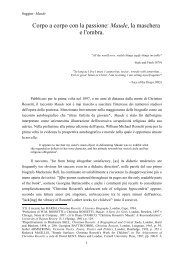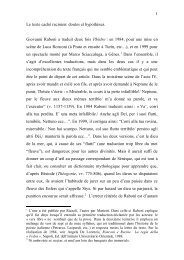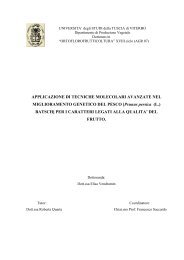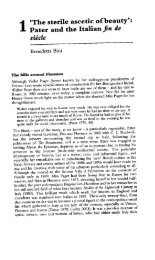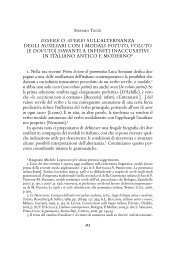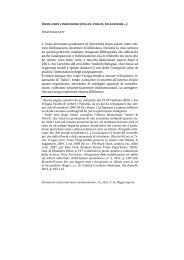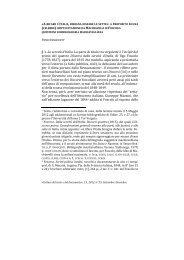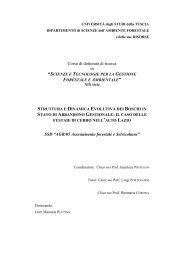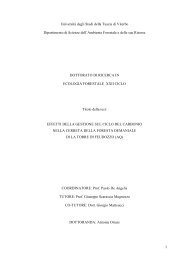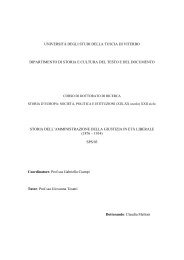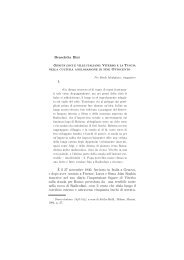drivers of soil respiration of root and microbial ... - Unitus DSpace
drivers of soil respiration of root and microbial ... - Unitus DSpace
drivers of soil respiration of root and microbial ... - Unitus DSpace
Create successful ePaper yourself
Turn your PDF publications into a flip-book with our unique Google optimized e-Paper software.
conditions, like <strong>soil</strong> type, plants cover, equipment, environmental conditions etc. Comprehensive<br />
reviews <strong>of</strong> these methods are given by Hanson (2000), Kuzyakov <strong>and</strong> Larionova (2005), Kuzyakov<br />
(2006), <strong>and</strong> Subke (2006). Most methods involve a certain degree <strong>of</strong> disturbance <strong>of</strong> the <strong>soil</strong> system that<br />
changes natural fluxes to an uncertain degree.<br />
Increasing number <strong>of</strong> studies have explored <strong>soil</strong> <strong>respiration</strong> in relation to environmental<br />
factors <strong>and</strong> across bioclimatic area, pointing out a different role <strong>of</strong> various ecosystems in the<br />
terrestrial C cycle <strong>and</strong> its feedbacks to climate change. Whilst <strong>soil</strong> <strong>respiration</strong> has been well<br />
characterized for range <strong>of</strong> forest ecosystems (recent synthesis by Janssens <strong>and</strong> al., 2001 Kane <strong>and</strong><br />
al., 2003; Hibbard et al., 2005; Rodeghiero <strong>and</strong> Cescatti, 2005) comparatively little is known about<br />
grassl<strong>and</strong>s.<br />
1.4. Importance <strong>of</strong> Grassl<strong>and</strong> ecosystems in global C balance.<br />
Grassl<strong>and</strong>s are one <strong>of</strong> the world’ s most widespread vegetation types <strong>and</strong> comprise 32% <strong>of</strong><br />
the earth’ s area <strong>of</strong> natural vegetation (Adams et al., 1990). Grassl<strong>and</strong>s play a significant role in<br />
carbon storage <strong>and</strong> is an important component <strong>of</strong> the global carbon cycle. Even so, there have been<br />
relatively few long-term studies <strong>of</strong> grassl<strong>and</strong> at the ecosystem level. At least in part, this is caused<br />
by the focus <strong>of</strong> many scientists on forests (e.g., Dolman et al., 2002; Valentini, 2003). Some<br />
researchers have tried to assess the carbon budget in grassl<strong>and</strong> (Kim et al . 1992; Dugas et al . 1999;<br />
Frank & Dugas 2001; Sims & Bradford 2001; Suyker & Verma 2001; Flanagan et al. 2002;<br />
Sousanna, 2004, Belelli et al. 2007). These studies suggest that grassl<strong>and</strong> ecosystems can be a sink<br />
<strong>of</strong> CO2 during their growing periods. However the grassl<strong>and</strong> estimate, which is derived from a<br />
simple model CESAR (Vleeshouwers <strong>and</strong> Verhagen, 2002), is the most uncertain (coefficient <strong>of</strong><br />
variation <strong>of</strong> 130%) among all l<strong>and</strong>-use types (Janssens et al., 2003). And the contribution <strong>of</strong> this<br />
sink to the global carbon budget has not been adequately clarified.<br />
Grassl<strong>and</strong> ecosystems are particularly complex <strong>and</strong> difficult to investigate because <strong>of</strong> the<br />
wide range <strong>of</strong> management <strong>and</strong> environmental conditions to which that they are exposed. Currently,<br />
the net global warming potential (in terms <strong>of</strong> CO2 equivalent) from the greenhouse gas exchanges<br />
with grassl<strong>and</strong>s is not known. It is clear that an integrated approach, that would allow quantifying<br />
the fluxes from all three radiatively active trace gases (CO2, CH4, N2O), would be desirable.<br />
Besides their natural aspect, grassl<strong>and</strong>s have a pure agricultural destination as a primary<br />
food source for wild herbivores <strong>and</strong> domesticated ruminants. Actually, grassl<strong>and</strong>s being a mixture<br />
<strong>of</strong> different grass species, legumes <strong>and</strong> herbs may act as carbon sinks, erosion preventives, bird<br />
directive areas, habitat for small animals, nitrogen fixation (Carlier et al. 2004).<br />
The grassl<strong>and</strong>’ s carbon cycle integrates exchanges <strong>of</strong> carbon in the form <strong>of</strong> organic matter<br />
among three compartments (<strong>soil</strong>, vegetation, herbivores) <strong>and</strong> under inorganic form as CO2 between<br />
19




